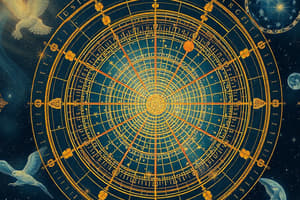Podcast
Questions and Answers
What are the two coordinates that allow us to locate an object in the sky?
What are the two coordinates that allow us to locate an object in the sky?
Azimuth and Altitude
True or False: Earth is closer to the Sun in summer and farther from the Sun in winter.
True or False: Earth is closer to the Sun in summer and farther from the Sun in winter.
False (B)
What is the key factor that causes the seasons on Earth?
What is the key factor that causes the seasons on Earth?
Axis Tilt
Earth's rotation axis is tilted by ____ degrees compared to the direction perpendicular to Earth's orbital plane.
Earth's rotation axis is tilted by ____ degrees compared to the direction perpendicular to Earth's orbital plane.
How many zodiac constellations are there actually?
How many zodiac constellations are there actually?
Why do we see phases of the Moon?
Why do we see phases of the Moon?
What phase of the Moon occurs when half of its face is bright and half dark?
What phase of the Moon occurs when half of its face is bright and half dark?
Why do we always see the same face of the moon?
Why do we always see the same face of the moon?
What causes eclipses?
What causes eclipses?
Flashcards are hidden until you start studying
Study Notes
The Celestial Sphere and Coordinate System
- The celestial sphere is an imaginary sphere of infinite radius centered on Earth, with the North and South Celestial Poles defined by the extensions of the Earth's North and South Poles.
- The celestial equator is the projection of the Earth's equator onto the celestial sphere, dividing it into the Northern and Southern Hemispheres.
- The celestial sphere can be divided into a grid of latitude and longitude, similar to the Earth's coordinate system.
- Right Ascension (RA) and Declination (Dec) are the celestial equivalents of longitude and latitude, used to locate objects in the sky.
- RA is measured in hours, minutes, and seconds, while Dec is measured in degrees, arcminutes, and arcseconds.
Measuring Angles
- Angular size is the angle subtended by an object at the observer's eye, measured in degrees, arcminutes, and arcseconds.
- Angular size depends on the physical size of the object and its distance from the observer.
The Moon and the Sun
- The Moon and Sun have nearly the same angular size, about 0.5 degrees.
- The Moon's distance from Earth is about 380,000 km, while the Sun's distance is about 150,000,000 km.
Celestial Sphere and the Observer
- The horizon is the flat plane where the observer stands, while the zenith is the point directly above the observer.
- The nadir is the point opposite the zenith, directly below the observer.
- An observer can see only half of the celestial sphere from any location on Earth.
Apparent Motion of Stars
- The Earth's rotation from west to east makes the celestial sphere appear to rotate from east to west.
- Depending on the observer's location, some stars will rise and set, while others will remain circumpolar.
The Zodiac and Constellations
- The zodiac constellations are the 12 constellations through which the Sun, Moon, and planets appear to pass as the Earth orbits the Sun.
- There are actually 13 zodiac constellations, including Ophiuchus, which is often overlooked.
- The Sun spends different amounts of time in each constellation, due to their varying sizes.
Seasons
- The Earth's axis tilt of 23.5 degrees is the main cause of the seasons.
- The distance between the Earth and the Sun varies by about 3% over the course of the year, but this has a negligible effect on the seasons.
- The orientation of the Earth's axis changes over time due to precession, which takes about 26,000 years to complete.
Motion of the Moon
- The Moon rises in the east and sets in the west, moving across the sky in an arc.
- The Moon moves slowly eastward against the stars, completing one orbit every 27.3 days.
- The Moon's elliptical orbit causes its angular diameter to vary, appearing larger when it is at perigee (closest to Earth) and smaller when it is at apogee (farthest from Earth).
Phases of the Moon
- The Moon's phases change as it orbits the Earth, due to the changing angle between the Moon, Earth, and Sun.
- The Moon's phases can be new, full, crescent, gibbous, or a combination of these.
- The time it takes the Moon to complete a full cycle of phases is about 29.5 days, called the synodic period.
Lunar and Solar Eclipses
-
Eclipses occur when the Earth or Moon passes through the other's shadow.
-
Lunar eclipses occur at full moon, while solar eclipses occur at new moon.
-
There are three types of lunar eclipses: total, partial, and penumbral, and three types of solar eclipses: total, partial, and annular.### Solar Eclipses
-
The Moon's orbit is tilted 5° to the ecliptic plane, which is why we don't have an eclipse at every new and full moon.
-
Two eclipse seasons occur each year, with a lunar eclipse at new moon and a solar eclipse at full moon.
Conditions for an Eclipse
- Two conditions must be met for an eclipse to occur:
- It must be full moon (for a lunar eclipse) or new moon (for a solar eclipse).
- The Moon must be at or near one of the two points in its orbit where it crosses the ecliptic plane (its nodes).
Predicting Eclipses
- Eclipses recur with the 18-year, 11 1/3-day saros cycle, but the type (e.g., partial, total) and location may vary.
- The next total solar eclipse seen from the continental US will be on August 21, 2017.
Phases of the Moon and Eclipses
- We see phases of the Moon because half of it is lit by the Sun, while half is in shadow, and its appearance to us is determined by the relative positions of the Sun, Moon, and Earth.
- A lunar eclipse occurs when the Earth's shadow falls on the Moon, while a solar eclipse occurs when the Moon's shadow falls on the Earth.
- The tilt of the Moon's orbit means that eclipses do not occur for every new or full moon, but rather during two periods each year.
Studying That Suits You
Use AI to generate personalized quizzes and flashcards to suit your learning preferences.




